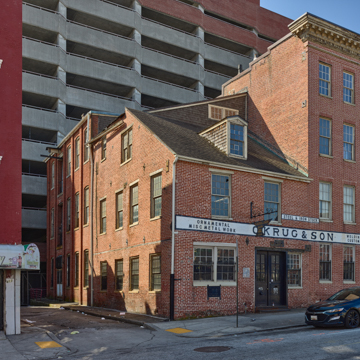Standing alone and seemingly out of step with its surroundings is a rare surviving early Baltimore ironworks recognized as the oldest continually operating blacksmith shop in the nation. Begun by blacksmith Augustus Schwatka, operations expanded under Gustav Krug to include architectural wrought and cast iron. Krug began working here in 1858, reestablishing the business as G. Krug and Son by 1871. This intriguing three-part brick industrial building now houses both an operating custom metal works manufactory and a museum reflecting Baltimore’s role in the development of architectural iron. They produced ornamental fences, railings, doors, locks, and such found on landmarks throughout the city including The Johns Hopkins Hospital, the Mercantile Safe Deposit and Trust Building, and the Baltimore Zoo.
The two-and-a-half-story, common-bond brick, Georgian-influenced section housed the original business, later repurposing the adjacent four-story, Flemish-bond brick residential building. The two sections are united by painted signage. A more decorative rear addition introduces round-arched windows separated by pilasters and a double-door entrance with a hoist for the egress of materials and finished products. Built as part of a post-Civil War expansion, it reflects the move from hand-made to steam-powered, machine-made processes to increase production and lower costs. While more modern technologies are currently employed, the business is still operated by the Krug family.







